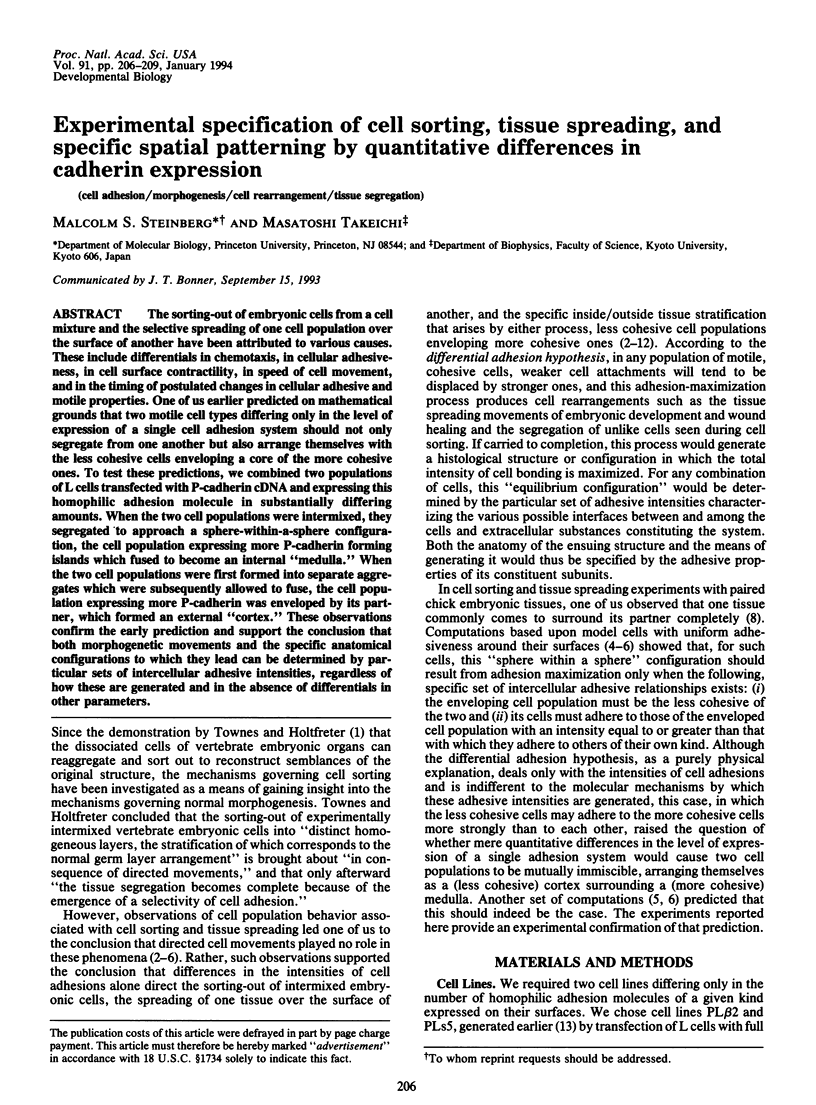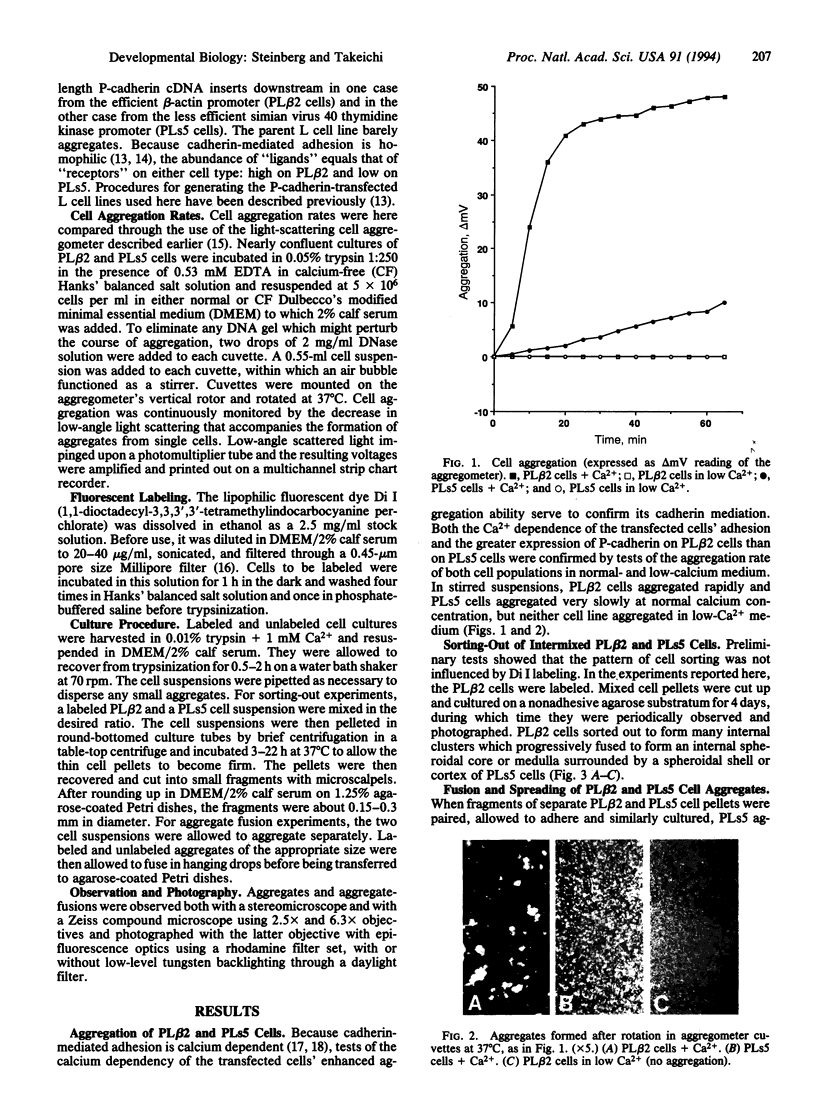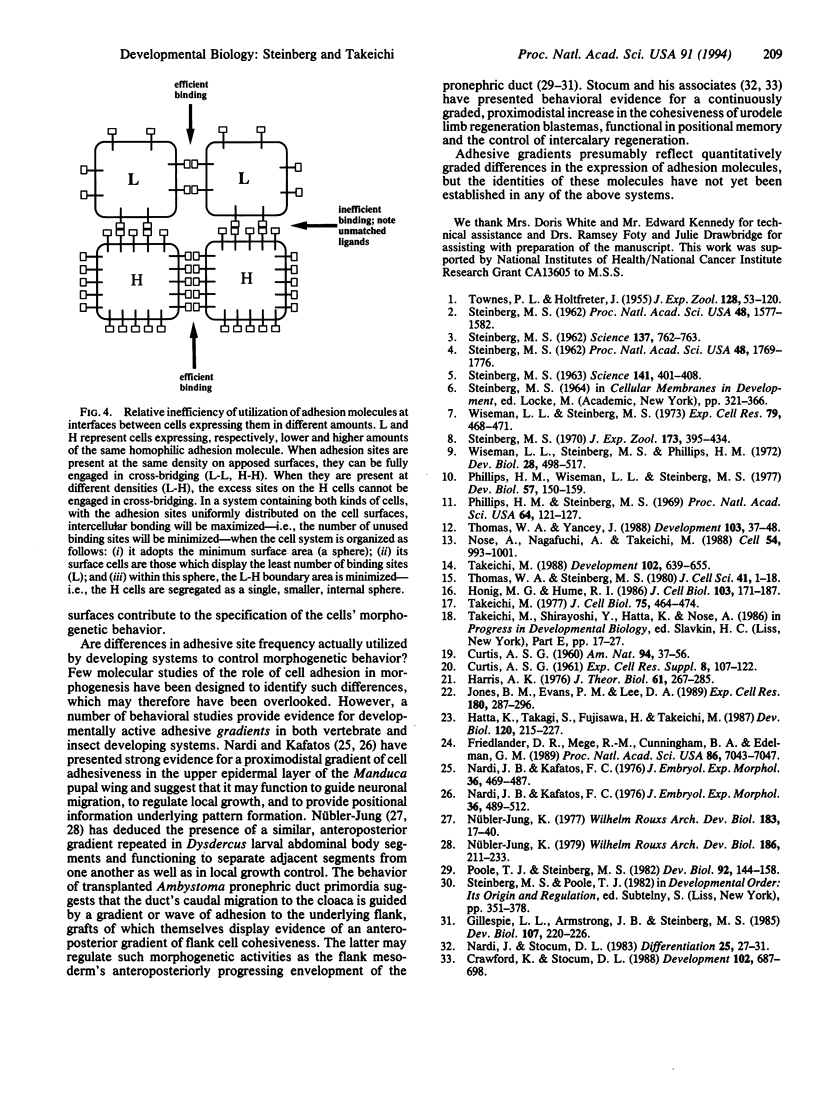Abstract
The sorting-out of embryonic cells from a cell mixture and the selective spreading of one cell population over the surface of another have been attributed to various causes. These include differentials in chemotaxis, in cellular adhesiveness, in cell surface contractility, in speed of cell movement, and in the timing of postulated changes in cellular adhesive and motile properties. One of us earlier predicted on mathematical grounds that two motile cell types differing only in the level of expression of a single cell adhesion system should not only segregate from one another but also arrange themselves with the less cohesive cells enveloping a core of the more cohesive ones. To test these predictions, we combined two populations of L cells transfected with P-cadherin cDNA and expressing this homophilic adhesion molecule in substantially differing amounts. When the two cell populations were intermixed, they segregated to approach a sphere-within-a-sphere configuration, the cell population expressing more P-cadherin forming islands which fused to become an internal "medulla." When the two cell populations were first formed into separate aggregates which were subsequently allowed to fuse, the cell population expressing more P-cadherin was enveloped by its partner, which formed an external "cortex." These observations confirm the early prediction and support the conclusion that both morphogenetic movements and the specific anatomical configurations to which they lead can be determined by particular sets of intercellular adhesive intensities, regardless of how these are generated and in the absence of differentials in other parameters.
Full text
PDF



Images in this article
Selected References
These references are in PubMed. This may not be the complete list of references from this article.
- CURTIS A. S. Timing mechanisms in the specific adhesion of cells. Exp Cell Res. 1961;Suppl 8:107–122. doi: 10.1016/0014-4827(61)90343-3. [DOI] [PubMed] [Google Scholar]
- Crawford K., Stocum D. L. Retinoic acid coordinately proximalizes regenerate pattern and blastema differential affinity in axolotl limbs. Development. 1988 Apr;102(4):687–698. doi: 10.1242/dev.102.4.687. [DOI] [PubMed] [Google Scholar]
- Friedlander D. R., Mège R. M., Cunningham B. A., Edelman G. M. Cell sorting-out is modulated by both the specificity and amount of different cell adhesion molecules (CAMs) expressed on cell surfaces. Proc Natl Acad Sci U S A. 1989 Sep;86(18):7043–7047. doi: 10.1073/pnas.86.18.7043. [DOI] [PMC free article] [PubMed] [Google Scholar]
- Gillespie L. L., Armstrong J. B., Steinberg M. S. Experimental evidence for a proteinaceous presegmental wave required for morphogenesis of axolotl mesoderm. Dev Biol. 1985 Jan;107(1):220–226. doi: 10.1016/0012-1606(85)90390-2. [DOI] [PubMed] [Google Scholar]
- Harris A. K. Is Cell sorting caused by differences in the work of intercellular adhesion? A critique of the Steinberg hypothesis. J Theor Biol. 1976 Sep 21;61(2):267–285. doi: 10.1016/0022-5193(76)90019-9. [DOI] [PubMed] [Google Scholar]
- Hatta K., Takagi S., Fujisawa H., Takeichi M. Spatial and temporal expression pattern of N-cadherin cell adhesion molecules correlated with morphogenetic processes of chicken embryos. Dev Biol. 1987 Mar;120(1):215–227. doi: 10.1016/0012-1606(87)90119-9. [DOI] [PubMed] [Google Scholar]
- Honig M. G., Hume R. I. Fluorescent carbocyanine dyes allow living neurons of identified origin to be studied in long-term cultures. J Cell Biol. 1986 Jul;103(1):171–187. doi: 10.1083/jcb.103.1.171. [DOI] [PMC free article] [PubMed] [Google Scholar]
- Jones B. M., Evans P. M., Lee D. A. Relation between the rate of cell movement under agarose and the positioning of cells in heterotypic aggregates. Exp Cell Res. 1989 Jan;180(1):287–296. doi: 10.1016/0014-4827(89)90233-4. [DOI] [PubMed] [Google Scholar]
- Nardi J. B., Kafatos F. C. Polarity and gradients in lepidopteran wing epidermis. I. Changes in graft polarity, form, and cell density accompanying transpositions and reorientations. J Embryol Exp Morphol. 1976 Dec;36(3):469–487. [PubMed] [Google Scholar]
- Nardi J. B., Kafatos F. C. Polarity and gradients in lepidopteran wing epidermis. II. The differential adhesiveness model: gradient of a non-diffusible cell surface parameter. J Embryol Exp Morphol. 1976 Dec;36(3):489–512. [PubMed] [Google Scholar]
- Nose A., Nagafuchi A., Takeichi M. Expressed recombinant cadherins mediate cell sorting in model systems. Cell. 1988 Sep 23;54(7):993–1001. doi: 10.1016/0092-8674(88)90114-6. [DOI] [PubMed] [Google Scholar]
- Phillips H. M., Steinberg M. S. Equilibrium measurements of embryonic chick cell adhesiveness. I. Shape equilibrium in centrifugal fields. Proc Natl Acad Sci U S A. 1969 Sep;64(1):121–127. doi: 10.1073/pnas.64.1.121. [DOI] [PMC free article] [PubMed] [Google Scholar]
- Phillips H. M., Wiseman L. L., Steinburg M. S. Self vs nonself in tissue assembly. Correlated changes in recognition behavior and tissue cohesiveness. Dev Biol. 1977 May;57(1):150–159. doi: 10.1016/0012-1606(77)90361-x. [DOI] [PubMed] [Google Scholar]
- Poole T. J., Steinberg M. S. Evidence for the guidance of pronephric duct migration by a craniocaudally traveling adhesion gradient. Dev Biol. 1982 Jul;92(1):144–158. doi: 10.1016/0012-1606(82)90159-2. [DOI] [PubMed] [Google Scholar]
- STEINBERG M. S. Mechanism of tissue reconstruction by dissociated cells. II. Time-course of events. Science. 1962 Sep 7;137(3532):762–763. doi: 10.1126/science.137.3532.762. [DOI] [PubMed] [Google Scholar]
- STEINBERG M. S. On the mechanism of tissue reconstruction by dissociated cells. I. Population kinetics, differential adhesiveness. and the absence of directed migration. Proc Natl Acad Sci U S A. 1962 Sep 15;48:1577–1582. doi: 10.1073/pnas.48.9.1577. [DOI] [PMC free article] [PubMed] [Google Scholar]
- STEINBERG M. S. Reconstruction of tissues by dissociated cells. Some morphogenetic tissue movements and the sorting out of embryonic cells may have a common explanation. Science. 1963 Aug 2;141(3579):401–408. doi: 10.1126/science.141.3579.401. [DOI] [PubMed] [Google Scholar]
- Steinberg M. S. Does differential adhesion govern self-assembly processes in histogenesis? Equilibrium configurations and the emergence of a hierarchy among populations of embryonic cells. J Exp Zool. 1970 Apr;173(4):395–433. doi: 10.1002/jez.1401730406. [DOI] [PubMed] [Google Scholar]
- Steinberg M. S. ON THE MECHANISM OF TISSUE RECONSTRUCTION BY DISSOCIATED CELLS, III. FREE ENERGY RELATIONS AND THE REORGANIZATION OF FUSED, HETERONOMIC TISSUE FRAGMENTS. Proc Natl Acad Sci U S A. 1962 Oct;48(10):1769–1776. doi: 10.1073/pnas.48.10.1769. [DOI] [PMC free article] [PubMed] [Google Scholar]
- Takeichi M. Functional correlation between cell adhesive properties and some cell surface proteins. J Cell Biol. 1977 Nov;75(2 Pt 1):464–474. doi: 10.1083/jcb.75.2.464. [DOI] [PMC free article] [PubMed] [Google Scholar]
- Takeichi M. The cadherins: cell-cell adhesion molecules controlling animal morphogenesis. Development. 1988 Apr;102(4):639–655. doi: 10.1242/dev.102.4.639. [DOI] [PubMed] [Google Scholar]
- Thomas W. A., Steinberg M. S. A twelve-channel automatic device for continuous recording of cell aggregation by measurement of small-angle light-scattering. J Cell Sci. 1980 Feb;41:1–18. doi: 10.1242/jcs.41.1.1. [DOI] [PubMed] [Google Scholar]
- Thomas W. A., Yancey J. Can retinal adhesion mechanisms determine cell-sorting patterns: a test of the differential adhesion hypothesis. Development. 1988 May;103(1):37–48. doi: 10.1242/dev.103.1.37. [DOI] [PubMed] [Google Scholar]
- Wiseman L. L., Steinberg M. S., Phillips H. M. Experimental modulation of intercellular cohesiveness: reversal of tissue assembly patterns. Dev Biol. 1972 Jul;28(3):498–517. doi: 10.1016/0012-1606(72)90033-4. [DOI] [PubMed] [Google Scholar]
- Wiseman L. L., Steinberg M. S. The movement of single cells within solid tissue masses. Exp Cell Res. 1973 Jun;79(2):468–471. doi: 10.1016/0014-4827(73)90473-4. [DOI] [PubMed] [Google Scholar]




